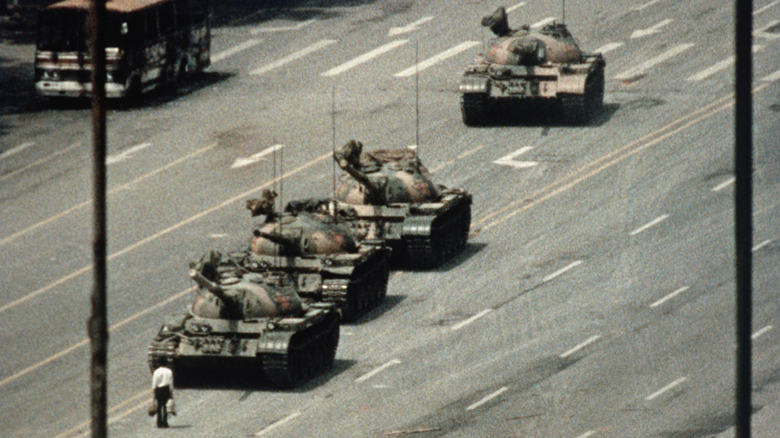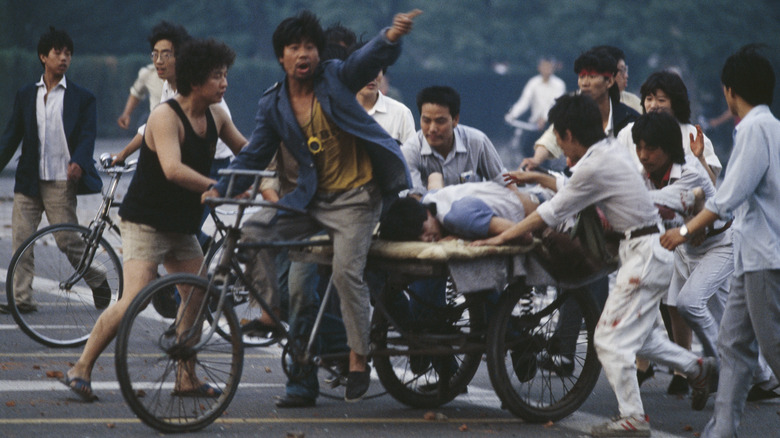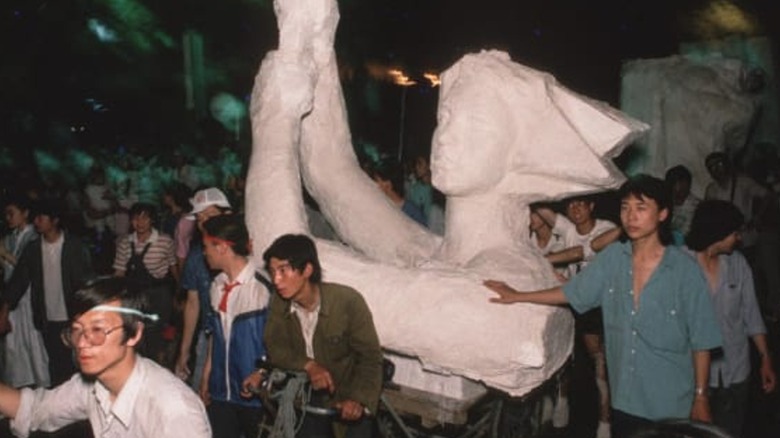What Happened To Victims' Bodies From The Tiananmen Square Massacre?
By June 4, 1989, up to 1 million protestors had gathered at Tiananmen Square in Beijing, China. Civil unrest had been growing since the mid-1980s after China economically integrated with the outside world and students started traveling abroad and learning about the civil liberties of other nations. And when former chairman and general secretary of the Chinese Communist Party (CCP) Hu Yaobang died in 1989, student-led protests swelled. In the months following Hu's April funeral tensions between people and government reached a breaking point.
Even though the Chinese government waffled for months about how to respond, they eventually sent in 300,000 troops to open fire on protestors. A diplomatic telegram uncovered as recently as 2017 estimated a civilian death toll of 10,000 over two days, per the BBC. In a piece for The Guardian, Chinese national Ma Jian — present at the time — said authorities spun the bloodbath as an "incident" and the peaceful protest as a "counter-revolutionary riot." And of course, the Tiananmen Square Massacre — as it came to be known to the rest of the world — granted us one of the most legendary visions of resistance possible in the form of "tank man" lifting a palm to oncoming tanks.
As for the bodies of the massacre's victims, much of what we know is scattered and somewhat unconfirmed. By all accounts some people were buried in makeshift graves, others desecrated by soldiers, some stacked outside of hospitals and disposed of later, and many cremated over time.
A bloodbath in the streets
When soldiers started firing into Tiananmen Square in the early morning of June 4, many students couldn't believe they were using live ammunition, as PBS reports. The outlet reported that the soldiers had received word to clear the square by 6:00 a.m. In a diplomatic telegram, British ambassador to China Sir Alan Donald wrote that students were given one hour to leave, and then fired upon five minutes later, per the BBC.
Donald described in vivid terms what happened. "Students linked arms but were mown down. ... Four wounded girl students begged for their lives but were bayoneted," he wrote. The telegram also gives us our first clue about the fate of some of the victims' bodies: "APCs [armored personnel carriers] then ran over bodies time and time again to make 'pie' and remains collected by bulldozer. Remains incinerated and then hosed down drains." Zhou Fengsuo, present for the massacre and a university student at the time, told NPR he appealed to soldiers' common humanity by asking, "Why do you work for Beijing in such a fashion, killing people? Do you have family?"
When all was said and done, survivors and loved ones couldn't even mourn openly for fear of further reprisal, as Amnesty International says. Chinese authorities swept through the country arresting, interrogating, and torturing those suspected of "counter-revolutionary" acts. And so we see the main reason behind the difficulty in untangling what happened to the victims of the Tiananmen Square Massacre: The Chinese government swept it all under the rug, even to this day.
Buried, burned, crushed, or discarded
In her award-winning 2014 book, "The People's Republic of Amnesia: Tiananmen Revisited," author Louisa Lim documents the best account we have of what happened to the victims of the Tiananmen Square Massacre — at least in the initial hours following events. Contrary to traditional Chinese customs of cremating the dead, some people were buried in impromptu graves in pell-mell fashion, like one person buried with two soldiers in a flowerbed near the entrance to a school.
As we said, some individuals were reportedly mashed by APCs and burned later, though the Chinese government has denied this. Then again, in his piece for The Guardian, eyewitness Ma Jian described authorities literally washing away the blood on the streets. Another above-mentioned eyewitness, Zhou Fengsuo, told NPR he saw "40 bodies on the ground in a bicycle shed." Local hospitals allegedly couldn't accommodate all the dead, so they started stacking them elsewhere.
Perhaps most pointedly, we know that some people at least received a proper cremation, albeit under distressing circumstances. When Ma Jian arrived back in Beijing in January 1990, the year after the Tiananmen Square Massacre, he described a neighbor who'd opened a crematorium saying, "The dead are making me rich! They're much nicer than the living!" Whether or not remains were still being burned by then — six months after the massacre — is unknown.
[Featured image by Osthyveln från Österrike via Wikimedia Commons | Cropped and scaled | CC BY-SA 4.0]


